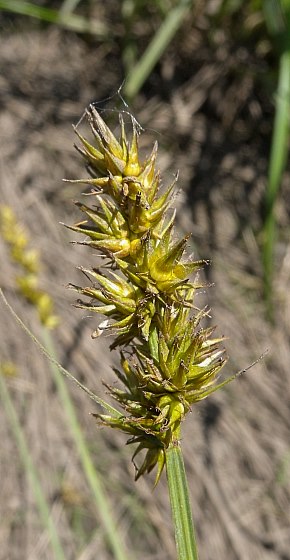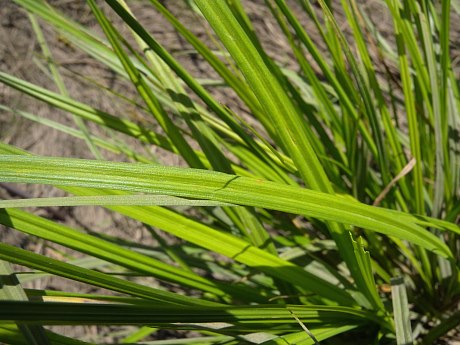Description:
This
perennial sedge forms an open tuft of flowering culms and
arching leaves about 1½–3' tall. The flowering culms are more or less
erect, but tend to topple over with age. The culms are light to medium
green, hairless, 3-angled, and slightly winged; they have a
compressible spongy texture. About 3-5 leaves are located along the
lower one-third of the culm. The leaf blades are up to 8 mm. across and
2' long, light to medium green, hairless, and rather floppy. The leaf
sheaths are light green and veined along
their outer sides, while
their inner sides are membranous; they are rather loose and tear easily
(especially along the inner sides), sometimes becoming netted in
appearance with age. Each fertile culm terminates in an inflorescence
about 1½–4" long. An inflorescence has several short spikelets
(especially toward the base) and it has a congested prickly appearance
overall. Individual floral bracts may occur at the bases of some lower
spikelets, but they are very slender and insignificant. Each spikelet
has several perigynia that are widely spreading to ascending; most
florets are female, although a few male florets occur near the apex of
each spikelet. The spikelets are light green while immature, becoming
gold-colored and finally turning brown at maturity. The perigynia of
the female florets are 4-5 mm. long and lanceoloid in shape with
slender elongated beaks; their inner sides are flat, while their outer
sides are convex. The pale bases of the perigynia are slightly inflated
and bulbous with tiny stipe-like beaks. The pistillate scales are
lanceolate and about 3 mm. long; they have green central veins and
broad membranous margins. The achenes are ovoid, slightly flattened,
and no more than 2.0 mm. long. The root system is fibrous and
short-rhizomatous.
light green and veined along
their outer sides, while
their inner sides are membranous; they are rather loose and tear easily
(especially along the inner sides), sometimes becoming netted in
appearance with age. Each fertile culm terminates in an inflorescence
about 1½–4" long. An inflorescence has several short spikelets
(especially toward the base) and it has a congested prickly appearance
overall. Individual floral bracts may occur at the bases of some lower
spikelets, but they are very slender and insignificant. Each spikelet
has several perigynia that are widely spreading to ascending; most
florets are female, although a few male florets occur near the apex of
each spikelet. The spikelets are light green while immature, becoming
gold-colored and finally turning brown at maturity. The perigynia of
the female florets are 4-5 mm. long and lanceoloid in shape with
slender elongated beaks; their inner sides are flat, while their outer
sides are convex. The pale bases of the perigynia are slightly inflated
and bulbous with tiny stipe-like beaks. The pistillate scales are
lanceolate and about 3 mm. long; they have green central veins and
broad membranous margins. The achenes are ovoid, slightly flattened,
and no more than 2.0 mm. long. The root system is fibrous and
short-rhizomatous.
Cultivation:
The preference is light shade to full sun and moist to slightly wet
conditions. This sedge adapts to a variety of soil types, including a
heavy clay-loam. In shaded situations, it tolerates drier conditions.
Range & Habitat:
The native Prickly Sedge is widely distributed in Illinois; in most
areas, it is
occasional to locally common (see Distribution
Map). Habitats include moist to wet bottomland woodlands,
moist depressions in upland woodlands, swamps, seeps and springs, wet
prairies, areas along ponds, and ditches. This sedge is found in both
degraded and higher quality habitats.
Faunal Associations:
The foliage of wetland sedges is eaten by Stethophyma lineata
(Striped Sedge Grasshopper) and Stethophyma celata
(Otte's Sedge Grasshopper). The caterpillars of several skippers and
butterflies also feed on the foliage, including Euphyes
conspicuus (Black Dash), Euphyes dion
(Dion Skipper), Euphyes dukesi (Duke's Skipper), Poanes
massasoit (Mulberry Wing), Poanes viator
(Broad-Winged Skipper), Polites mystic (Long Dash),
Satyrodes appalachia (Appalachian Brown), and Satyrodes
eurydice (Eyed Brown). The seeds of sedges are eaten by the
seed bugs Cymus angustatus and Oedancala
dorsalis, while the larvae of several billbugs (Sphenophorus
spp.) live in the stems. Seedheads of wetland sedges are a source of
food for Mallards and other ducks, several rails, woodcocks, Swamp
Sparrows, and some upland gamebirds. The foliage is rarely eaten by
White-Tailed Deer.
Photographic
Location:
Near a pond at Weaver Park in Urbana, Illinois.

Comments: Prickly Sedge has a sprawling habit and spiky seedheads. It is similar in appearance to several other sedges, except that its perigynia have unusually long tapered beaks, while their bases are pale and swollen. The most similar species is Carex laevivaginata, which has sheaths that are thickened at their summits and less likely to shred. The perigynia of this sedge are longer (5.0–6.5 mm.) than those of Prickly Sedge, its leaves are less floppy, and its seedheads don't become golden-colored as they mature. Another common name of Carex stipata is Awl-Fruited Sedge.